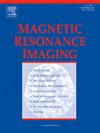Less is more? Performance of loops without distributed capacitors for 7 T MRI applications
IF 2
4区 医学
Q2 RADIOLOGY, NUCLEAR MEDICINE & MEDICAL IMAGING
引用次数: 0
Abstract
We present an exploration of loops without distributed capacitors (i.e. plain loops) for their suitability as RF coils in 7 T MRI applications. Herein, we report on the differences between a circular -i.e. round- plain loop, an elliptic -i.e. elongated- plain loop, a conventional loop - i.e. a loop with distributed capacitors - and a dipole. This comparison highlights the benefits and limitations of plain loops, providing insights into their viability as an alternative to more complex coil designs for the construction of RF coil arrays at 7 T. We characterized the coils in terms of surface current distribution, robustness to loading, transmit efficiency, , coupling, and “flexibility” - defined as the ability of a coil to stay tuned () after mechanical deformation at a constant distance from the load. Additionally, we discussed the best practice to fabricate plain loops. A 12 cm round plain loop was more sensitive to the coil load distance than a conventional loop, but it was flexible and can be operated at a roughly constant distance from different patients. The antenna showed similar transmit properties to a 12 cm round conventional loop but with lower coupling (∼44 % less) when the loops were gapped or overlapped less than 20 %. A 62 mmx280mm elongated plain loop was more robust than a dipole to the coil-load distance, providing similar transmit efficiency for imaging of the prostate, with lower worst case (∼25 % less), but higher coupling (S21 ∼ -15 dB). This paper provides the groundwork for further optimizing plain loops in UHF-MRI coil arrays.
少即是多?7个 T MRI应用中无分布式电容器的环路性能。
我们提出了一种不带分布式电容器的环路(即普通环路)的探索,因为它们在7 T MRI应用中适合作为射频线圈。在此,我们报告了圆形-即圆形-平坦环路,椭圆形-即拉长-平坦环路,常规环路-即分布电容器环路和偶极子之间的区别。这种比较突出了普通回路的优点和局限性,提供了它们作为7 T下构建RF线圈阵列的更复杂线圈设计的替代方案的可行性。我们从表面电流分布、负载稳健性、传输效率、maxSAR10g、耦合和“灵活性”(定义为线圈在与负载保持一定距离的机械变形后保持调谐(S11≤- 10db)的能力)等方面对线圈进行了表征。此外,我们还讨论了制作普通循环的最佳实践。12 cm圆形平环对线圈负载距离比常规环更敏感,但它灵活,可以在与不同患者的大致恒定距离上操作。该天线的发射性能与12 cm圆的传统环相似,但当环间隙或重叠小于20 %时,耦合降低(约44 %)。62 mmx280mm的细长平面环路比偶极子对线圈负载距离的鲁棒性更强,为前列腺成像提供了相似的传输效率,最坏情况下maxSAR10g更低(约25% %),但耦合更高(S21 ~ -15 dB)。本文为进一步优化UHF-MRI线圈阵列中的平面环路奠定了基础。
本文章由计算机程序翻译,如有差异,请以英文原文为准。
求助全文
约1分钟内获得全文
求助全文
来源期刊

Magnetic resonance imaging
医学-核医学
CiteScore
4.70
自引率
4.00%
发文量
194
审稿时长
83 days
期刊介绍:
Magnetic Resonance Imaging (MRI) is the first international multidisciplinary journal encompassing physical, life, and clinical science investigations as they relate to the development and use of magnetic resonance imaging. MRI is dedicated to both basic research, technological innovation and applications, providing a single forum for communication among radiologists, physicists, chemists, biochemists, biologists, engineers, internists, pathologists, physiologists, computer scientists, and mathematicians.
 求助内容:
求助内容: 应助结果提醒方式:
应助结果提醒方式:


